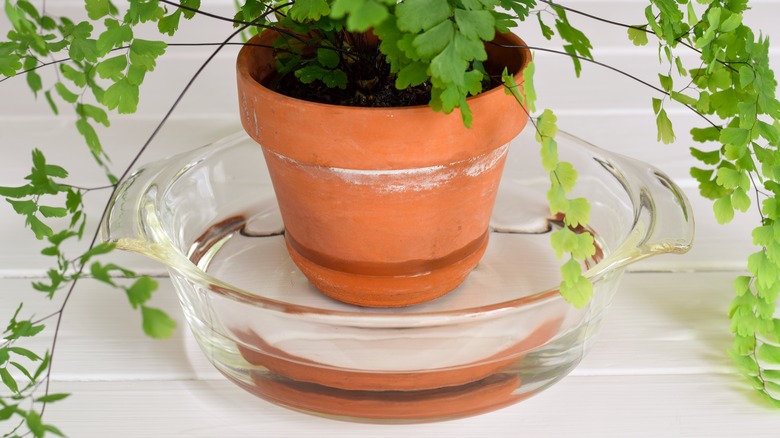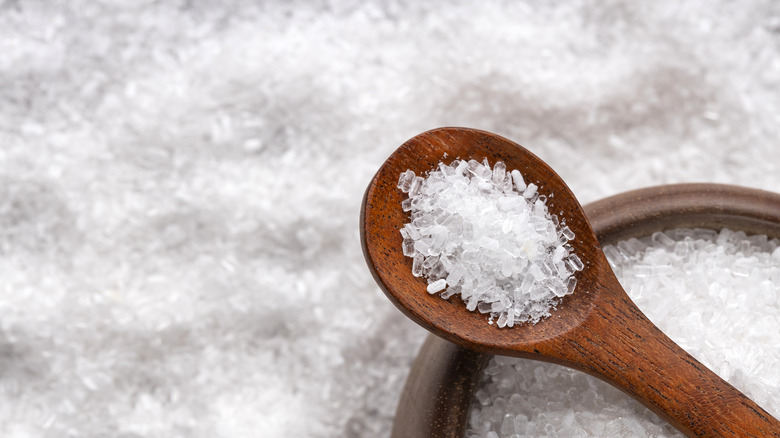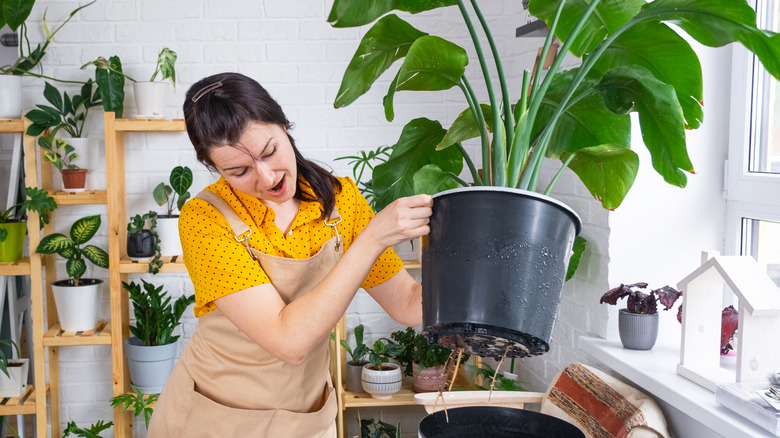Pot Soaking Is The Ultimate Way To Give Your Indoor Plants A Boost With Epsom Salt
A happy house plant needs good soil plus sufficient water and sunlight in order to thrive. But if you want to encourage growth combined with big flowers and fruits, you might want to add Epsom salt to your watering routine. And not just that. Some plant lovers say you also need to change your watering method for optimal results.
So, how does Epsom salt help? Many gardeners believe the magnesium in Epsom salt supplements needed nutrients in the soil, spurring growth and leading to bigger blooms. Others say adding the salt can actually kill your plants at worst, or do nothing at best, calling this cure-all a myth. Still, there is sufficient evidence that, added correctly, Epsom salt can improve plant health.
Before you simply pour that water and salt mixture into the top of your pots, consider pot soaking. This watering hack involves submerging the base of your pots into water so they soak up moisture from the bottom up. Offering water this way reduces the risk of root rot and offers more even watering. And it could be the key to boosting your plants' health.
What we know about Epsom salts and plants
Epsom salt gets its name from the English town where it was first discovered. It looks a lot like table salt, but it is magnesium sulfate, not sodium chloride. Research on the effects of adding Epsom salt to plants shows that many plants, specifically in agriculture, benefit from having magnesium sulfate added to soil either as a fertilizer. After all, plants need magnesium sulfate to make chlorophyll for photosynthesis. Many experts point out that Epsom salt is only beneficial if your soil has shown to be deficient in magnesium sulfate through soil testing. Others point out that these studies have only looked at crop production, an intensive practice known to deplete soil of its nutrients.
So it's important to consider that not all plants like Epsom salt. Avoid offering this mixture to carnivorous species, such as Venus fly traps, which have actually adapted for growth in soil that is missing nutrients. Similarly, magnesium chloride has proven to be toxic to both pine trees and coniferous trees, so it's best to avoid its cousin magnesium sulfate. Finally, many tropical plants will experience leaf yellowing with Epsom salt, so it's best to use with caution. On the flip side both, fruit and vegetable crops such as beans, tomatoes, peppers, corn, and cabbage seem to love it.
How to pot soak your house plants with Epsom salt
There are plenty of smart ways to use Epsom salt around the house. When it comes to plants, your first step is to mix the appropriate ratio of salt to water. It's recommended to start with one tablespoon of Epsom salt dissolved in a gallon of water. Be careful not to overdo it. Potted plants are more susceptible to magnesium toxicity, which prevents roots from absorbing other key nutrients.
According to many gardeners, you should be bottom watering your house plants, or pot soaking. You'll need to use a container with high sides or pot larger than the one your plant currently uses to hold water. Fill the larger container with the mixed ratio of Epsom salt and water — for plants in 3-gallon pots, start with a teaspoon of Epsom salt total – then set your pot inside and let it absorb the water through the drainage holes into the lower levels of soil for 30 minutes to an hour. Whatever you do, don't spray your plant's leaves with the solution as this can scorch the plant.
Gardeners say pot soaking allows soil to absorb water and remain moist without inducing root rot. It's also a more direct way of helping water reach all of the soil, instead of pouring water into the top of the pot where it runs in certain directions. Some plant lovers say you should soak your clay pots before using them as well, but this has mixed results.


